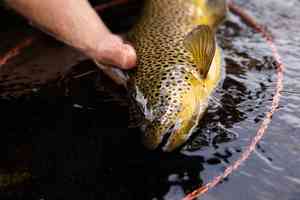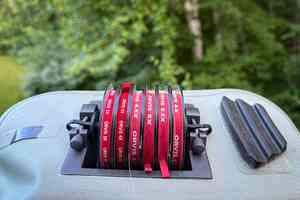The first time I cast a Pure 2 was a blustery spring day in Twin Bridges, Montana. I was there to interview Hank Haen, Winston’s new Design and Manufacturing Engineer, for my podcast (everyone has a podcast these days). When we finished, he casually asked if I wanted to cast a “sweet little prototype rod” he’d been working on.
A few minutes later we were outside with a handful of rods leaning against the workshop wall. Hank handed me a rod with the guides taped on and said, “Don’t worry if the reel seat moves, I never glued it on there. I just wanted to see how the rod casts.” It was a close-to-final version of the 7’9” 4-weight Pure 2 and it cast like a dream. The rod flexed with a lively, yet relaxed, action that would be perfect for small dry fly work, but it wasn’t a slouch against the stiff breeze, either. Put simply, the Pure 2 felt exactly like the sort of dry fly-centric rod you’d expect from Winston.
I spent the last few months of the season with production models of the Pure 2, fishing them in clouds of tricos and during the remaining caddis hatches of the year.
The Winston Pure 2 replaces the original Pure series, which has already gained a bit of a cult following amongst Winston aficionados. While those rods are good—I own an 8’ 3-weight myself—the Pure 2 is a significant step forward for a few reasons.
What Works
Consistent Feel and Action
The original Pure sticks were built as almost one-off rods, so that 8’ 3-weight I own is faster and stiffer than the 8’6” 4-weight. Each rod in that first run of Pures had a different feel and action, often more so than you’d expect.
With the Pure 2, Hank Haen redesigned the rods from the ground up, which he says allowed him to ensure every rod in the new family has a consistent feel and action.
“The big accomplishment with these rods is that they all fit in the box where you put a true to line weight on them and they’ll cast great,” Haen said. “You get a phenomenal amount of feel with each rod.”
In my time with the rods, I found Scientific Anglers’ Amplitude Trout Standard line worked best. It’s a true-to-weight line with a gradual taper that paired well with the progressive medium action of the Pure 2. I also threw an SA Amplitude Infinity and a 406 DT, before settling on the Trout Standard as the best line for these rods.
The Pure 2 delivered all the feedback I’d expect in a rod designed for delicate dry fly work to wary fish. Casting felt natural and relaxed, and I didn’t have to consciously think about my timing like I do when reviewing some rods. The Pure 2 excelled at 20-30 feet, which is exactly what you’d want a rod like this to do.
The 7’9” 4-weight was fantastic on small streams with short casts that were more leader and fly than line. The 8’3” 5-weight had the guts to push small tricos out to distance, but also the softness to lay those flies down with the subtlety they demand.
Unique Rod Lengths
Winston’s Pure 2 isn’t available in an 8’ or 8’6” 4-weight. Those are often the gold standard models for dry fly fishing, and some of the most popular Winstons of all time are one of those configurations.
Instead, Haen opted to cut the popular lengths down by three inches, although you can still buy a 9’ 4 and 5-weight. This was done to give the rods more torsional stability, and to make them lighter.
Shorter rods are inherently more accurate because they have less side-to-side movement during a cast. By taking an 8’ 4-weight and turning it into a 7’9” 4-weight, you don’t lose hardly anything in terms of reach, but you gain a noticeable amount of torsional stability. The end result is a rod that has an uncanny ability to drop flies exactly where they need to land.
I’m a middling caster, and I’m the first to admit my own accuracy needs help. The Pure 2 didn’t dramatically transform my casting accuracy, but I noticed a difference, especially at distances past 40 feet. A great rod can only do so much in the hands of an average caster, but the Pure 2 did enough to show me that these shorter lengths aren’t just a marketing gimmick from Winston.
New Materials
The Pure 2 features the new “NanoParticle Double-Bonded” graphite technology, which allowed Winston to replace boron entirely. I’m told this is similar to the technology in the Air 2, the company’s flagship rod.
Boron is a relatively stiff material, so ditching it allows for increased feel and flex throughout the blank. That’s not to say the Pure 2 is a noodle—far from it—but that it’s noticeably more sensitive than the original Pure.
Winston also dropped the grip from the original Pure and used the same 6.5-inch cigar grip found on the Air 2. Cork grips on the first run of Pure rods were polarizing because they had a significant swell which forced many people to hold the rod further forward or backward than they were used to. The new grip is slimmer and a bit longer.
What Doesn’t Work
Lack of Versatility
The only knock I think you can make against the Pure 2 is that these rods are a bit of a one-trick pony. These are dry-fly rods, and while you can throw a wide variety of dry flies with them, that’s what they’re built for.
The 7’9” 4-weight handled a size 16 Parachute Adams and size 18 Zebra Midge dry-dropper rig just fine on my local freestone, and the 8’3” 5-weight was fine with most nymphs. The 5-weight did great with hoppers (I had to throw a few just for curiosity’s sake), but it’s not a rod I’d pick for a day of hopper-dropper fishing in the middle of summer.
Sure, you can fish nymphs on these rods, and probably do alright, but they’re not the most effective tool for the job. If you value a rod that has a wide range of abilities, you’d be happier with the Air 2.
Final Word
The Winston Pure 2 is a legitimate upgrade from the Pure. With the new design ethos and upgraded materials, you end up with a rod that’s dialed in for advanced dry-fly work. They’re accurate, lively, and light, but still have the backbone to deal with wind and big fish. If I had to imagine a fly rod made specifically for casting PMDs on a large spring creek, it’d be the Pure 2.
It’s harder now than it was 20 years ago to build a fly rod that feels like it does things better than its predecessor, as opposed to just doing them differently. The Pure 2 is a significant step up from the Pure in every performance aspect.






























Comments